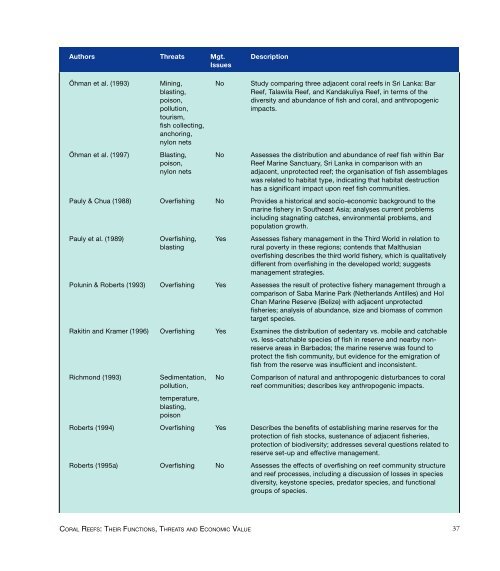You also want an ePaper? Increase the reach of your titles
YUMPU automatically turns print PDFs into web optimized ePapers that Google loves.
Authors Threats Mgt. Description<br />
Issues<br />
Öhman et al. (1993) Mining, No Study comparing three adjacent coral reefs in Sri Lanka: Bar<br />
blasting,<br />
Reef, Talawila Reef, and Kandakuliya Reef, in terms <strong>of</strong> the<br />
poison,<br />
diversity and abundance <strong>of</strong> fish and coral, and anthropogenic<br />
pollution,<br />
impacts.<br />
tourism,<br />
fish collecting,<br />
anchoring,<br />
nylon nets<br />
Öhman et al. (1997) Blasting, No Assesses the distribution and abundance <strong>of</strong> reef fish within Bar<br />
poison,<br />
Reef Marine Sanctuary, Sri Lanka in comparison with an<br />
nylon nets<br />
adjacent, unprotected reef; the organisation <strong>of</strong> fish assemblages<br />
was related to habitat type, indicating that habitat destruction<br />
has a significant impact upon reef fish communities.<br />
Pauly & Chua (1988) Overfishing No Provides a historical and socio-economic background to the<br />
marine fishery in Southeast Asia; analyses current problems<br />
including stagnating catches, environmental problems, and<br />
population growth.<br />
Pauly et al. (1989) Overfishing, Yes Assesses fishery management in the Third World in relation to<br />
blasting<br />
rural poverty in these regions; contends that Malthusian<br />
overfishing describes the third world fishery, which is qualitatively<br />
different from overfishing in the developed world; suggests<br />
management strategies.<br />
Polunin & Roberts (1993) Overfishing Yes Assesses the result <strong>of</strong> protective fishery management through a<br />
comparison <strong>of</strong> Saba Marine Park (Netherlands Antilles) and Hol<br />
Chan Marine Reserve (Belize) with adjacent unprotected<br />
fisheries; analysis <strong>of</strong> abundance, size and biomass <strong>of</strong> common<br />
target species.<br />
Rakitin and Kramer (1996) Overfishing Yes Examines the distribution <strong>of</strong> sedentary vs. mobile and catchable<br />
vs. less-catchable species <strong>of</strong> fish in reserve and nearby nonreserve<br />
areas in Barbados; the marine reserve was found to<br />
protect the fish community, but evidence for the emigration <strong>of</strong><br />
fish from the reserve was insufficient and inconsistent.<br />
Richmond (1993) Sedimentation, No Comparison <strong>of</strong> natural and anthropogenic disturbances to coral<br />
pollution,<br />
reef communities; describes key anthropogenic impacts.<br />
temperature,<br />
blasting,<br />
poison<br />
Roberts (1994) Overfishing Yes Describes the benefits <strong>of</strong> establishing marine reserves for the<br />
protection <strong>of</strong> fish stocks, sustenance <strong>of</strong> adjacent fisheries,<br />
protection <strong>of</strong> biodiversity; addresses several questions related to<br />
reserve set-up and effective management.<br />
Roberts (1995a) Overfishing No Assesses the effects <strong>of</strong> overfishing on reef community structure<br />
and reef processes, including a discussion <strong>of</strong> losses in species<br />
diversity, keystone species, predator species, and functional<br />
groups <strong>of</strong> species.<br />
CORAL REEFS: THEIR FUNCTIONS, THREATS AND ECONOMIC VALUE<br />
37


















